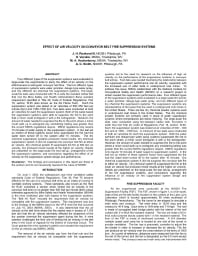Mining Publication: Effect of Air Velocity on Conveyor Belt Fire Suppression Systems
Original creation date: February 2009
Authors: JH Rowland, HC Verakis, MA Hockenberry, AC Smith
NIOSHTIC2 Number: 20035058
2009 SME Annual Meeting and Exhibit, February 22-25, Denver, Colorado, preprint 09-135. Littleton, CO: Society for Mining, Metallurgy, and Exploration, Inc., 2009; :1-6
Four different types of fire suppression systems were evaluated in large-scale fire experiments to study the effect of air velocity on the effectiveness to extinguish conveyor belt fires. The four different types of suppression systems were water sprinkler, deluge type water spray, and two different dry chemical fire suppression systems. The large-scale fire tests were conducted with 72-in-wide fire resistant rubber belt that met the Mine Safety and Health Administration flame resistant requirement specified in Title 30, Code of Federal Regulations, Part 18, section 18.65 (also known as the 2G Flame Test). Each fire suppression system was tested at air velocities of 500-550 feet per minute (fpm) and 1350-1500 fpm. Two tests were conducted at both air velocities for each fire suppression system. Both of the water-based fire suppression systems were able to suppress the fire to the point that a miner could extinguish it with a fire extinguisher. However, the amount of water needed to suppress the fire to the point where a miner could walk up to extinguish any smoldering belting was greater than the current MSHA regulations require. MSHA regulations only require 10 minutes of water supply to the suppression system. In the test set up neither of these systems would have suppressed the fire had the water been turned off to the system after 10 minutes. The dry chemical suppression systems produced mixed results. Dry chemical suppression system A did not suppress the conveyor belt fire at either air velocity. Dry chemical system B suppressed the fire at 500 fpm air velocity, but produced mixed results at the higher air velocity. Details are presented on the large-scale fire test set-up, arrangement of the fire suppression systems, and conclusions regarding the effect of air velocity on fire suppression system design and performance.

NIOSHTIC2 Number: 20035058
2009 SME Annual Meeting and Exhibit, February 22-25, Denver, Colorado, preprint 09-135. Littleton, CO: Society for Mining, Metallurgy, and Exploration, Inc., 2009; :1-6